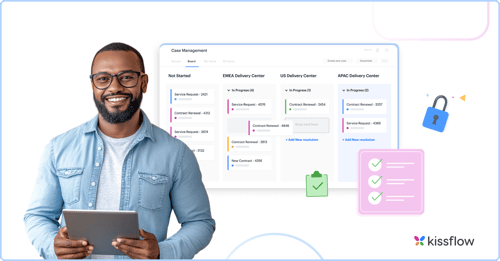
- >
- Application Development >
- Everything You Need to Know About Application Development Security and Compliance
Everything You Need to Know About Application Development Security and Compliance
Team Kissflow
Updated on 28 Apr 2025 • 7 min read
In recent years, application development platform has become one of the key strategies for achieving digitalization goals for businesses of all sizes. Enterprise apps help businesses streamline internal operations, boost productivity, and enhance customer service.
However, relying on enterprise software comes with its own set of challenges. Enterprise applications have become one of the weakest links prone to malicious attacks.
The growing adoption of mobile apps has increased vulnerability risk and exposure. According to a 2022 report by Forrester, up to 35 percent of external attacks on businesses exploit vulnerabilities in software and about 32 percent exploit vulnerabilities in web applications.
The numerous benefits of enterprise apps mean their usage is not about to slow down in the coming years. Instead, organizations will continue to demand more software apps with even greater complexity.
To keep up with these demands, developers must work more to safeguard the application development platform. This post details all you need about app development security and compliance, including common security issues and the steps or best practices to keep apps secure and compliant.
Definition of application development security and compliance
Application development security measures to prevent a data breach or code hijacking in software applications. A combination of software and hardware security techniques, best practices, and standard procedures is often involved to protect enterprise apps from all forms of external and internal security threats.
Application security includes all security measures and considerations followed during app development and the additional measures meant to secure the app even after deployment.
Application development compliance is adhering to regulatory requirements, industry standards, and best practices to ensure that software applications meet legal and ethical standards. Compliance is crucial for protecting user data, maintaining trust, and avoiding legal penalties.
The need for security and compliance in businesses
Software vulnerabilities are more common than you might want to believe. According to a 2019 Application Security Statistics Report, up to 50 percent of apps used by organizations that have no DevSecOps in place are vulnerable to attacks.
In one study, Veracode scanned 85,000 apps used across some 2,300 companies worldwide. They discovered that 83 percent of these apps have at least one security flaw. Although not all of these vulnerabilities are serious, they may open the door to other critical vulnerabilities that put your business operations at risk.
At the very least, a breach in a poorly secured application can lead to downtime or service disruptions. At the same time, a more severe security vulnerability can be exploited to steal sensitive user or business data.
Non-compliance with regulatory requirements can result in hefty fines, legal penalties, and loss of customer trust. For example, the General Data Protection Regulation (GDPR) imposes penalties of up to 4 percent of annual global turnover or €20 million (whichever is greater) for non-compliance.
Typical security and compliance issues in applications
New security threats and issues arise daily, making building fully secure and compliant applications challenging. However, there are a few common issues you should at least mitigate against as part of your standard application development security and compliance. They’re highlighted below.
1. Access control
If anyone can access your application due to poor access control, it poses a significant threat to your business. That’s because malicious actors often try to brute-force their way into apps by exploiting security issues with access authentication and authorization. Access control must be a top priority in enterprise app development to prevent attackers from gaining unrestricted access to your database or server. Access control is necessary for both offline and online applications.
2. Insecure storage
Enterprise apps often handle and store critical and sensitive business (and user) data. To secure all this data, it is essential to prioritize application security. Insecure data increases the risk of cyberattack since attackers can easily access the database to steal or manipulate data. In addition to securing your database, you must invest in data encryption, especially when transmitting or sending data is necessary. Ensuring that attackers cannot read the data, even if intercepted or hijacked, is crucial for maintaining security.
3. Injection attack
Malicious actors may sometimes enter malicious commands or inject harmful codes that negatively impact an app or its users. The absence of an efficient system to validate data entered from external sources makes your app an easy target for attackers. An injection attack may result in data loss or corruption, denial of access, or even a total takeover of your application.
4. Insider attack
An insider attack is a software vulnerability involving the organization’s current or former employees. It occurs when these individuals misuse their legitimate access, intentionally (malicious insider) or inadvertently (careless insider), exposing the organization to security threats. Although insider attacks are often difficult to prevent, organizations can limit their impact by restricting access for individual users based on roles, protecting critical assets, and putting measures in place to ensure visibility.
5. Non-compliance with regulations
Non-compliance with regulatory requirements can lead to legal penalties, fines, and a loss of customer trust. To ensure that your applications meet compliance requirements, staying updated with industry standards and regulations such as GDPR, HIPAA, and PCI-DSS is essential.
The impact of insecure and non-compliant applications
Businesses rely on software and apps to power nearly everything they do. The stakes are a lot higher whenever attacks happen. A lack of proper security and compliance in app development leaves vulnerabilities in your applications that allow hackers or malicious actors to roam free in your app whenever they want to. A cascade of negative impacts can occur, potentially resulting in financial loss, reputational damage, sanctions, and fines, or even crippling a business entirely.
These negative impacts of insecure and non-compliant applications are why businesses cannot afford to ignore security and compliance when building applications. The following are some of the potential impacts:
Financial costs
Arguably, the most obvious negative impact of insecure applications is the financial loss as a result of cyber attacks. According to an IBM report, the global average data breach cost in 2023 was USD 4.45. This cost comes in different ways depending on the type and nature of the attack.
For instance, a ransomware attack on a major application that powers your day-to-day operation can halt operations completely, leading to significant revenue costs. The business will also have to spend money on remediating the attack and sometimes pay hefty fines or settle lawsuits due to such attacks.
Learn more about application development cost.
Operational impacts
Malicious actors may exploit security vulnerabilities to launch attacks that take your system offline or make operation impossible for a long period. According to a survey by Allianz Risk Barometer, 45 percent of experts surveyed believe cyber incidents are the most feared cause of business interruptions.
Software attacks impact productivity, making it impossible to serve customers effectively. Securing applications after an attack also requires your IT to spend more time on system maintenance and updates, adding to the IT team’s workload and distracting them from their core responsibilities. In more serious instances, a data breach may result in losing critical operational data, such as trade secrets or personal contact information, which competitors can use against your business. Implementing robust security measures to prevent breaches and remove personal contact information from vulnerable databases is crucial.
Reputational damage
Another reason to take app security seriously is the reputational damage from security breaches. Customers who use your application entrust their data to you. When a security breach exposes this data, it erodes customer trust and loyalty to your brand, leading to a loss of business and brand value. Insecure applications can also raise red flags for investors and partners, impacting future business opportunities.
Small attacks may lead to bigger attacks.
Sometimes, the risk of software vulnerabilities is not apparent right away. Malware can remain dormant within your software for a long time. During this time, malicious actors can slowly gather data, steal information, and even leverage your software for a larger attack. Long-term cyber attacks like this can significantly harm your business, customers, and employees. Also, smaller and seemingly insignificant software vulnerabilities can be combined and used in larger attack chains with a bigger impact on business.
The ripple effect of secure and compliant applications
Software security and compliance must be integral to creating trustworthy apps for any security-conscious business. This intricate task involves securing the technical app development tools you use to build, designing secure and compliant apps, and ensuring the app development process follows standard security protocols and regulatory requirements. Your team’s people and culture can also impact your application’s security and compliance. When implemented correctly, some of the potential benefits for businesses include:
Reduced risk of attacks
Building secure apps involves implementing measures to reduce security vulnerabilities and detect potential threats before malicious actors can exploit them. Reducing app vulnerabilities reduces the risk of attacks, which is crucial to avoid the cost, downtime, and stress that come from trying to remediate attacks after they have occurred.
Boost in confidence
Building secure and compliant apps protects your application’s internal and external users’ data. A lack of confidence in-app security and compliance is one factor that may limit the adoption of business apps. Building a secure and compliant system enhances customer confidence. It fosters a sense of trust and peace of mind, enhancing customers’ overall experience.
No business disruptions
Identifying security risks and compliance issues and mitigating them at the development stage of your application prevents costly security breaches from happening later on. It also prevents disruptions or downtime and the other cascading issues that come with them, such as a drop in productivity, financial loss, and an overstretched IT.
Competitive advantage
In a world where data breaches have become commonplace, companies that manage to build secure and compliant apps are more likely to stand out in the market. Your software will likely be adopted faster, leading to greater market reach, growth, and new business opportunities.
How to secure app development and ensure compliance
In enterprise app development, making your app more secure and compliant has to be a top priority. Following standard procedures and best practices can help preserve your software’s integrity and ensure it meets regulatory requirements.
In addition to these practices, advanced security solutions like managed detection and response services, which have proven crucial in averting emergencies, must be considered. These services enhance threat identification and improve response times, mitigating vulnerabilities before malicious actors exploit them.
Some of these best practices to secure app development and ensure compliance include:
Secure coding
Application security begins with designing and writing your code. Secure coding refers to the practice of designing and writing code in a way that adheres to standard security practices. Following these security standards protect your code from unexpected, unknown, and known vulnerabilities that hackers may try to exploit.
Encrypt data
Encrypting your software source code and all data stored or transmitted through it is one way to secure your application data. While encryption does not prevent your app data from getting hijacked, it makes it unusable for the attackers who stole it. Use the latest encryption protocols, such as AES and SHA256, to protect your apps better. Encryption keys should also be stored away from the app and never on it.
Test your application
Many developers ignore security testing in a rush to deploy apps or roll out new features quickly. Pen-testing before deploying your app helps determine any vulnerability or security flaw. It can help identify new vulnerabilities you were unaware of while verifying if the measures you implemented to detect known vulnerabilities were efficient.
Keep software up-to-date
After deploying an app, patches and security updates should be released as frequently as possible. You should update the software code based on internal quality tests and user feedback. Performing patches, releasing updates, and encouraging users to download these updates will prevent hackers from exploiting any loopholes in the previous versions of your app.
Stay updated with regulatory requirements
Ensure your development team understands and adheres to regulatory requirements such as GDPR, HIPAA, and PCI-DSS. Regularly review and update your compliance policies to ensure your applications meet industry standards and legal requirements.
Conduct regular compliance audits
Regular compliance audits help identify gaps in your compliance efforts and ensure that your applications meet regulatory requirements. Conducting these audits can help you stay ahead of potential compliance issues and avoid legal penalties.
Conclusion
Malicious activities pose an ever-present risk, and as enterprises adopt more applications, this threat is bound to increase. Therefore, developers must prioritize app security and compliance during and after their apps have been deployed. Following the best practices stipulated above will ensure the integrity of enterprise apps and prevent the potential loss and damage that may result from exploiting security vulnerabilities and non-compliance with regulatory requirements.
At Kissflow, we understand the critical importance of security and compliance in enterprise application development. Our platform is designed with robust security measures and compliance protocols to ensure your applications are secure, reliable, and meet all regulatory standards. By choosing Kissflow, you can focus on your business goals while we handle app security and compliance complexities.
Elevate your enterprise application development with Kissflow's top-notch security and compliance
Related Articles











